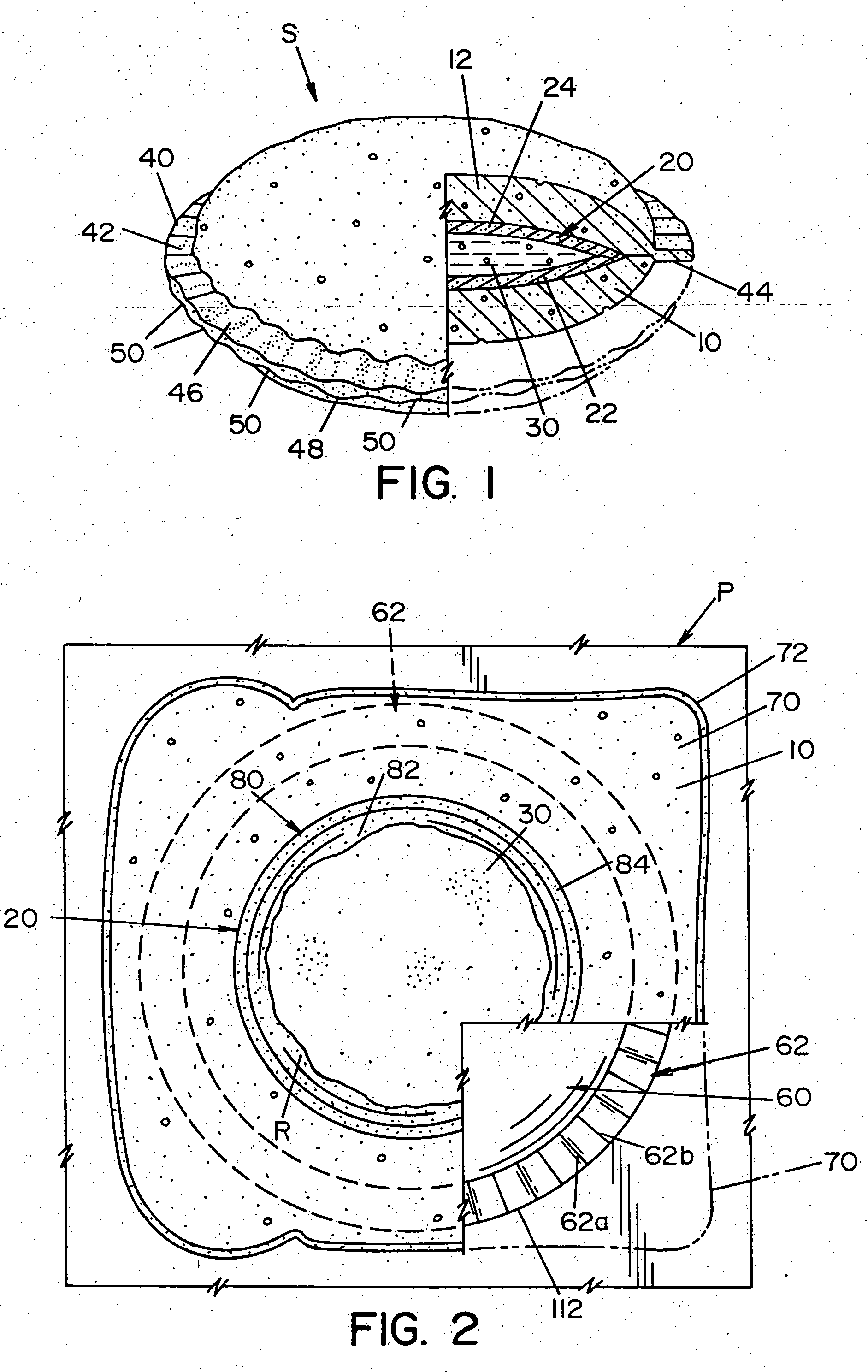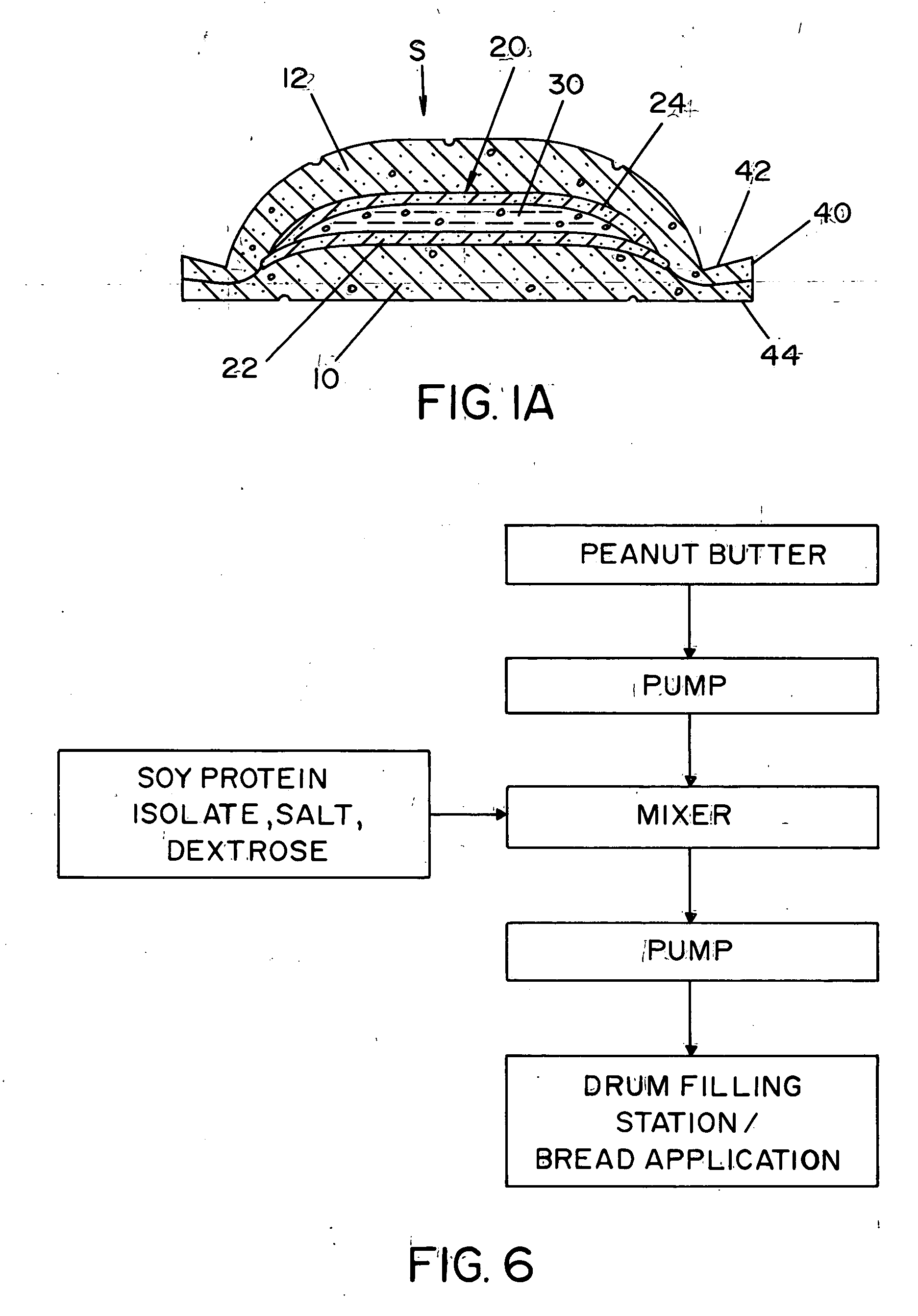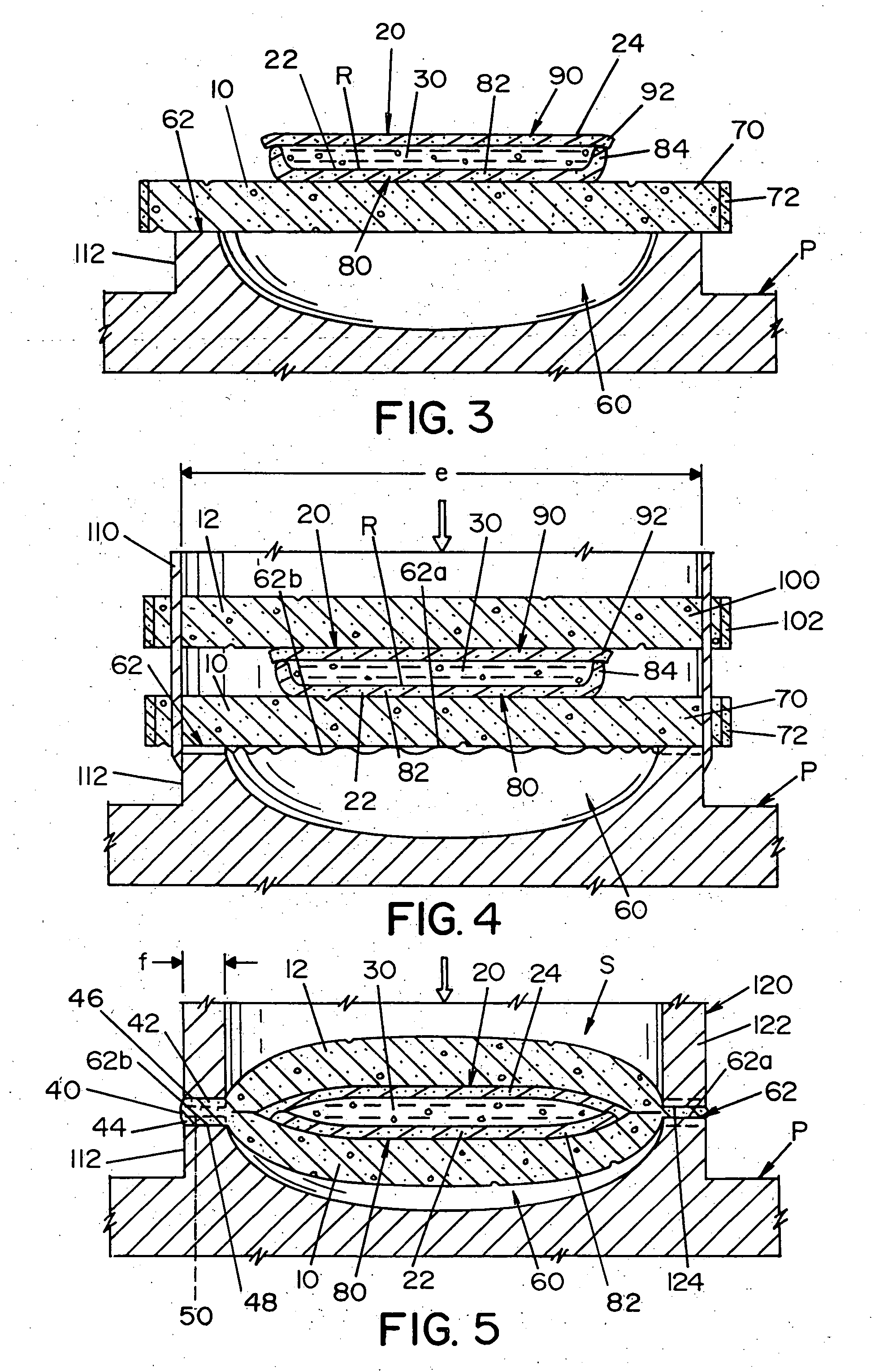High protein peanut butter and jelly sandwich and method of making the same
a peanut butter and jelly sandwich technology, applied in confectionery, baking, baking, etc., can solve the problems of not being able to guarantee a substantially complete seal around the periphery of the sandwich, not allowing the optimum formation of a seal between the two bread layers, and other catering establishments not able to achieve the effect of reducing calories and reducing calories
Inactive Publication Date: 2004-10-21
THE J M SMUCKER CO
View PDF50 Cites 8 Cited by
- Summary
- Abstract
- Description
- Claims
- Application Information
AI Technical Summary
Benefits of technology
[0011] In still another and / or alternative aspect of the present invention, the caloric content of the nut butter is reduced and the nutritional value of the nut butter is increased. One type of nut butter is peanut butter. A two (2) tablespoon serving of peanut butter typically has about 185-195 calories, about 15.5-16.5 grams of fat and about 7.5-8.5 grams of protein. A typical peanut butter and jelly sandwich includes about 2-4 tablespoons of peanut butter. As such, the caloric, fat and protein content of the peanut butter of a typical peanut butter and jelly sandwich is about 185-390 calories, about 15.5-33 grams of fat, and about 7.5-17 grams of protein. The present recommended dietary allowances for kids and adolescents is as follows:1 Nutrient Boy / Girl 4-6 (44 lbs.) Boy / Girl 7-10 (62 lbs.) Calories 1800 2000 Protein (g) 24 28 Fat (g) 60 66 Boys Girls 11-14 15-18 11-14 15-18 Nutrient (99 lbs.) (145 lbs.) (101 lbs) (120 lbs.) Calories 2500 3000 2200 2200 Protein (g) 45 59 46 44 Fat (g) 83 100 73 73
[0034] Still yet another and / or alternative object of the present invention is to provide a sealed crustless sandwich that can be stored for extended periods of time.
Problems solved by technology
These devices were used in home kitchens and did not allow optimum formation of a seal between the two bread layers.
Such hand operated processes for producing crustless sandwiches with seal peripheries were not adapted for mass production to produce retail volumes of crustless sandwiches that must maintain a seal and good appearance over long times. The peripheral seal obtained by prior procedures used in the home, restaurants and other catering establishments did not guarantee a substantially complete seal around the periphery of the sandwich.
It was found that the prior procedures resulted in the bread memory and improper seal causing an opening of the edges of the sandwich after long storage.
This bread squeezing action caused a progressive pinching that resulted in a thin squeezed shut seam.
Apparently, due to the realization of the inconsistencies and the lack of an adequate peripheral seal obtainable by manual devices for creating crustless sandwiches, the automated process shown in Sollerud abandoned the concept of crimping flat peripheral areas as the bread was cut.
But, this type of process formed a very narrow sealing area that lacked integrity and had a pressure gradient inward of the edge.
Such process was not usable technology for mass producing crustless sandwiches for retail distribution.
This squeezing action distorted the periphery of the crustless sandwich but did not guarantee integrity between the bread slices.
The outer tube of butter was used to prevent the jam from coming into contact with the bread, which was not desirable because of the property of the jam.
This is not consistent with peanut butter and jelly sandwiches.
The peanut butter would melt and create a mess.
A toasted jam sandwich is not appealing to many children and possibly explains the lack of commercial impact of the 1974 patent.
Peanut butter and jelly sandwiches have posed a significant problem in pre-preparation in that the bread becomes soggy over time, even when the sandwich is stored in a refrigerator or freezer.
Prior to Kretchman, is was not possible to make a standard peanut butter and jelly sandwich for freezing and retail distribution.
Unfortunately, young adults can be very particular concerning the types of foods they will consume.
Method used
the structure of the environmentally friendly knitted fabric provided by the present invention; figure 2 Flow chart of the yarn wrapping machine for environmentally friendly knitted fabrics and storage devices; image 3 Is the parameter map of the yarn covering machine
View moreImage
Smart Image Click on the blue labels to locate them in the text.
Smart ImageViewing Examples
Examples
Experimental program
Comparison scheme
Effect test
example 1
[0061]
3 Pre-made peanut butter 60-99 wt. % Nutritional enhancer(s) 0.5-40 wt. % Flavoring agent(s) 0-25 wt. %
example 2
[0062]
4 Pre-made nut butter 60-99 wt. % Protein Supplement 0-40 wt. % Vitamin / Mineral 0-30 wt. % Supplement Fiber Supplement 0-25 wt. % Flavoring agent 0-25 wt. %
example 3
[0063]
5 Pre-made nut butter 60-99 wt. % Protein Supplement(s) 1-40 wt. % Vitamin / Mineral 0-30 wt. % Supplement(s) Fiber Supplement 0-20 wt. % Flavoring agent(s) 0.1-25 wt. %
the structure of the environmentally friendly knitted fabric provided by the present invention; figure 2 Flow chart of the yarn wrapping machine for environmentally friendly knitted fabrics and storage devices; image 3 Is the parameter map of the yarn covering machine
Login to View More PUM
 Login to View More
Login to View More Abstract
A crustless sandwich made from two slices of baked bread. The sandwich includes first and second matching crustiess bread pieces. The bread pieces have the same general outer shape defined by an outer periphery with central portions surrounded by an outer peripheral area, the bread pieces being at least partially crimped together at the outer peripheral area. A central composite food layer is positioned between the central portions of the bread pieces and spaced inwardly of the crimped outer periphery area. The composite food layer includes a first and second layer of a first food spread and a second food spread that is substantially encapsulated between the first and second layer of the first food spread. The first food spread is nutritionally enhanced.
Description
[0001] The present invention relates to sandwiches, and more specifically, it relates to a sealed sandwich for providing a convenient sandwich which can be stored for long periods of time without a central filling leaking outwardly, and even more specifically to a peanut butter and jelly sandwich having a high protein content.INCORPORATION BY REFERENCE[0002] There are numerous prior art sandwiches and methods and devices used to make such sandwiches. Such patents include U.S. Pat. Nos. 2,780,163; 3,690,898; 3,782,270; Des. 252,536; Des. 293,040; Des. 317,672; Des. 318,360; 4,608,918; 5,112,632; 5,387,149; 5,500,234; 6,004,596, all of which are incorporated herein by reference. In addition, the prior art includes several patents relating to the manufacture and formulation of peanut butter. Such patents include, U.S. Pat. Nos. 6,312,754; 6,153,250; 6,063,430; 5,942,275; 5,885,646; 5,693,357; 5,591,477; 5,518,755; 5,508,057; 5,490,999; 5,433,970; 5,240,734; 4,814,195; 4,288,378; 4,000,...
Claims
the structure of the environmentally friendly knitted fabric provided by the present invention; figure 2 Flow chart of the yarn wrapping machine for environmentally friendly knitted fabrics and storage devices; image 3 Is the parameter map of the yarn covering machine
Login to View More Application Information
Patent Timeline
 Login to View More
Login to View More Patent Type & Authority Applications(United States)
IPC IPC(8): A21D13/00
CPCA21D13/0025A21D13/32
Inventor EBERHART, DUANE NATHANLARSEN, STEVEN BLAIR
Owner THE J M SMUCKER CO
Features
- R&D
- Intellectual Property
- Life Sciences
- Materials
- Tech Scout
Why Patsnap Eureka
- Unparalleled Data Quality
- Higher Quality Content
- 60% Fewer Hallucinations
Social media
Patsnap Eureka Blog
Learn More Browse by: Latest US Patents, China's latest patents, Technical Efficacy Thesaurus, Application Domain, Technology Topic, Popular Technical Reports.
© 2025 PatSnap. All rights reserved.Legal|Privacy policy|Modern Slavery Act Transparency Statement|Sitemap|About US| Contact US: help@patsnap.com



